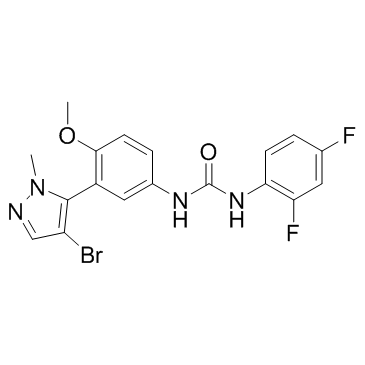| Description: |
Nelotanserin is a potent 5-HT2A inverse agonist, a moderately potent 5-HT2C partial inverse agonist and a weak 5-HT2B inverse agonist, with IC50s of 1.7, 79, 791 nM in IP accumulation assays, respectively. |
| Target: |
5-HT2A Receptor:1.7 nM (IC50)
5-HT2C Receptor:79 nM (IC50)
5-HT2B Receptor:791 nM (IC50) |
| In Vivo: |
Each compound is tested in a minimum of five rats by oral gavage with administration occurring in the middle of the inactive period, 6 h after light onset. The delta power during non-REM sleep (NREMS) is significantly different between all the analogues tested and the vehicle control. Nelotanserin (Compound 39) produces significant increases in delta power that persist for the first 4 h following dosing. Significant differences are found, however, in NREMS bout length. Nelotanserin significantly increases NREMS bout length during the first hour following dosing, and 3 does so during the second hour. In conjunction with this increased NREM bout duration, the number of NREM bouts decrease during the first hour for Nelotanserin (p<0.01) as well as for compound 15 (p<0.05)[2]. |
| In Vitro: |
Results from IP accumulation assays suggest that Nelotanserin is a potent 5-HT2A full inverse agonist (IC50=1.7 nM), a moderately potent 5-HT2C partial inverse agonist (IC50=79 nM) (maximal response was 62% of the response obtained for the reference inverse agonist clozapine), and a weak 5-HT2B inverse agonist (IC50=791 nM). Nelotanserin displays high affinity for recombinant human 5-HT2A receptors (Ki=0.35 nM), moderate affinity for human 5-HT2C receptors (Ki=100 nM), and low affinity for human 5-HT2B receptors (2000 nM) stably expressed in HEK293 cells. The results suggest that Nelotanserin has a 262-fold higher affinity for human 5-HT2A than 5-HT2C receptors and a 6610-fold higher affinity for human 5-HT2A than 5-HT2B receptors[1]. |
| References: |
[1]. Al-Shamma HA et al. Nelotanserin, a novel selective human 5-hydroxytryptamine2A inverse agonist for the treatment of insomnia. J Pharmacol Exp Ther. 2010 Jan;332(1):281-90.
[2]. Teegarden BR et al. Discovery of 1-[3-(4-bromo-2-methyl-2h-pyrazol-3-yl)-4-methoxyphenyl]-3-(2,4-difluorophenyl)urea (nelotanserin) and related 5-hydroxytryptamine2A inverse agonists for the treatment of insomnia. J Med Chem. 2010 Mar 11;53(5):1923-36. |






















